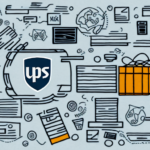Developing a Winning Shipping Ecommerce Marketing Strategy
As the ecommerce industry continues to grow, shipping has become an essential part of any successful ecommerce marketing strategy. The success of your ecommerce business hinges on your ability to provide excellent shipping options and a seamless, hassle-free experience for your customers. In this article, we will explore the key elements of developing a winning shipping ecommerce marketing strategy that will help you stand out in the market and grow your business.
Understanding the Importance of Shipping in Ecommerce Marketing
Shipping is more than just getting products from point A to point B. It's about creating a positive customer experience that will keep your customers coming back. Poor shipping practices can lead to negative reviews, damaged products, delayed shipments, and lost customers. On the other hand, excellent shipping practices can increase customer loyalty, repeat business, and positive reviews.
According to a Forbes article, efficient shipping can boost customer satisfaction by up to 30%. One way to improve your shipping practices is to offer multiple shipping options to your customers. This allows them to choose the option that best fits their needs and budget. Additionally, providing tracking information and updates can help ease any anxiety or uncertainty your customers may have about their shipment.
Another important aspect of shipping is packaging. Proper packaging can prevent damage to products during transit and ensure that they arrive in good condition. It's also an opportunity to add branding and marketing materials to the package, further promoting your business and creating a memorable unboxing experience for your customers.
Analyzing Your Target Audience for Successful Shipping Strategies
Before you can create a successful shipping strategy, you need to understand your target audience. Analyzing your target audience enables you to determine their needs, preferences, and expectations when it comes to shipping. For example, some customers might prioritize fast shipping over low cost, while others might prefer free shipping. You can use this data to create shipping options that meet their needs and exceed their expectations.
Another important factor to consider when analyzing your target audience is their location. Shipping costs and delivery times can vary greatly depending on where your customers are located. By understanding where your customers are located, you can create shipping options that are tailored to their specific region. This can help you save on shipping costs and improve delivery times.
It's also important to consider the type of products you are shipping and the packaging required. Fragile or perishable items may require special packaging and handling, which can affect shipping costs and delivery times. By analyzing your target audience and their preferences, you can determine the best packaging and shipping methods to ensure that your products arrive safely and in a timely manner.
Identifying Your Shipping Goals and Objectives
The next step in developing a winning shipping ecommerce marketing strategy is to identify your shipping goals and objectives. What do you want to achieve with your shipping strategy? Do you want to increase customer satisfaction, reduce shipping costs, or increase speed? Identifying your goals and objectives will enable you to focus your efforts on the areas that matter most.
Once you have identified your shipping goals and objectives, it is important to regularly evaluate and adjust your strategy as needed. This may involve analyzing shipping data, customer feedback, and industry trends to ensure that your shipping strategy remains effective and competitive. By staying proactive and adaptable, you can continue to meet the evolving needs of your customers and stay ahead of the competition.
Choosing the Right Shipping Options for Your Ecommerce Store
Choosing the right shipping options is crucial to the success of your ecommerce marketing strategy. You need to offer shipping options that meet your customer's needs and align with your shipping goals and objectives. Some of the most popular shipping options include free shipping, flat rate shipping, real-time shipping rates, and expedited shipping.
- Free Shipping: Attracts more customers but can cut into profit margins.
- Flat Rate Shipping: Provides predictable costs for both you and your customers.
- Real-Time Shipping Rates: Offers accurate pricing based on the weight and destination of each package.
- Expedited Shipping: Ideal for customers needing quick delivery, though it may not be feasible for all products or destinations.
It's important to consider the cost and logistics of each shipping option before making a decision. Real-time shipping rates, for example, require integration with a shipping carrier's API but can enhance customer satisfaction by providing accurate pricing.
Evaluating the Costs of Different Shipping Strategies
Evaluating the costs of different shipping strategies is essential to ensure that your shipping strategy is profitable. You need to consider both direct costs, such as shipping fees and packaging materials, and indirect costs, such as labor and overhead. According to a report by Statista, shipping costs account for approximately 10-15% of total ecommerce expenses.
One important factor to consider when evaluating shipping costs is the distance between your business and your customers. Shipping costs can vary greatly depending on the distance, and it's important to factor this into your overall shipping strategy. Additionally, you may want to consider offering free shipping for orders over a certain amount, as this can incentivize customers to purchase more and can help offset some of the shipping costs.
Another consideration when evaluating shipping costs is the type of products you are shipping. Fragile or heavy items may require special packaging or handling, which can increase shipping costs. It's important to factor in these additional costs when determining your overall shipping strategy and pricing.
Optimizing Your Order Fulfillment Process for Maximum Efficiency
Order fulfillment is one of the most critical aspects of shipping. To optimize your order fulfillment process, you need to ensure that you have a smooth, streamlined process for packaging and shipping orders. This process should be efficient, accurate, and timely to meet your customer's expectations.
One way to optimize your order fulfillment process is to invest in automation technology. Automated systems can help you reduce errors, increase speed, and improve accuracy. For example, automated packaging machines can quickly and accurately package your products, reducing the time it takes to fulfill an order.
Another important factor in optimizing your order fulfillment process is to have clear communication with your customers. You should provide them with regular updates on the status of their order, including tracking information and estimated delivery dates. This will help to build trust and confidence in your brand, and ensure that your customers are satisfied with their purchase experience.
Creating a Seamless Customer Experience Through Shipping
Creating a seamless customer experience is essential to retaining your customers and encouraging repeat business. To create a seamless customer experience, you need to ensure that your shipping strategy aligns with your overall brand message and image. This can include things like branded packaging and tracking information.
Another important aspect of creating a seamless customer experience through shipping is providing multiple shipping options. Customers have different preferences and needs when it comes to shipping, so offering a variety of options such as standard, expedited, and same-day delivery can help meet their expectations. Additionally, providing clear and accurate shipping information, including estimated delivery dates and any potential delays, can help build trust with your customers and improve their overall experience.
Leveraging Technology to Enhance Your Shipping Strategies
Technology can play a significant role in enhancing your shipping ecommerce marketing strategy. For example, you can use shipping software to automate your order fulfillment process, track shipments, and manage returns. Tools like ShipStation or FedEx Ship Manager offer comprehensive solutions for managing shipping operations efficiently.
You can also use data analytics to analyze your shipping performance, identify areas for improvement, and make proactive adjustments to your strategy. According to a study by Harvard Business Review, businesses that leverage data analytics in their shipping strategies can reduce costs by up to 20% while improving delivery times.
Another way technology can enhance your shipping strategy is by offering customers more shipping options. By integrating with multiple carriers, you can provide customers with a range of shipping speeds and prices to choose from. This can improve customer satisfaction and increase sales, as customers are more likely to complete a purchase if they have shipping options that meet their needs.
Additionally, technology can help you streamline your shipping operations and reduce costs. For example, you can use shipping software to compare carrier rates and select the most cost-effective option for each shipment. You can also use automation to reduce manual errors and save time on tasks like printing shipping labels and packing slips.
Building a Strong Relationship with Your Shipping Partners
Building a strong relationship with your shipping partners is crucial to the success of your ecommerce marketing strategy. Your shipping partners can directly impact the customer experience, so it's essential to work with reliable, efficient partners who share your values. Building a strong relationship with your shipping partners can also lead to better rates, improved fulfillment times, and smoother operations.
One way to build a strong relationship with your shipping partners is to communicate regularly and openly. This means sharing your business goals and expectations, as well as providing feedback on their performance. By keeping the lines of communication open, you can work together to identify areas for improvement and make adjustments as needed.
Another important factor in building a strong relationship with your shipping partners is to treat them as valued partners, rather than just vendors. This means showing appreciation for their hard work and dedication, and recognizing the important role they play in your business. By building a strong relationship based on mutual respect and trust, you can create a partnership that benefits both your business and your shipping partners.
Measuring and Analyzing the Success of Your Shipping Strategy
Measuring and analyzing the success of your shipping strategy is essential to making data-driven decisions and continuously improving your ecommerce marketing strategy. You can use data analytics to track Key Performance Indicators (KPIs) such as shipping times, returns, and customer satisfaction to determine what's working and what's not.
Tools like Google Analytics and Tableau can help you visualize and interpret your shipping data effectively. According to a report by McKinsey & Company, businesses that implement regular performance analysis experience a 15% increase in operational efficiency.
Implementing Continuous Improvement in Your Ecommerce Shipping Strategy
Continuous improvement is critical to success in ecommerce marketing. By continually analyzing and refining your shipping strategy, you can stay ahead of the competition and anticipate customer needs. This can include everything from improving your order fulfillment process to adding new shipping options or partnering with new carriers.
Adopting methodologies like Lean or Six Sigma can help streamline your shipping processes and eliminate inefficiencies. Regularly soliciting customer feedback can also provide valuable insights into areas where your shipping strategy can be enhanced.
Effectively Communicating with Customers About Shipping Policies and Procedures
Effective communication with your customers is critical to creating a positive customer experience. You need to ensure that your customers understand your shipping policies and procedures, including estimated delivery times, tracking information, and returns processes. This can help to reduce confusion and ensure that your customers have a clear understanding of what to expect.
Implementing clear and concise information on your website, such as an FAQ section or detailed shipping policy pages, can enhance transparency. Additionally, sending automated emails with tracking links and delivery updates can keep customers informed throughout the shipping process.
Overcoming Common Challenges and Roadblocks in Ecommerce Shipping
There are several common challenges and roadblocks that ecommerce businesses face when it comes to shipping. These can include things like shipping delays, lost shipments, and damaged products. By understanding these challenges and proactively addressing them, you can create a more resilient and successful shipping ecommerce marketing strategy.
Implementing robust tracking systems and reliable shipping partners can mitigate the risk of lost shipments. Additionally, investing in quality packaging materials and training your staff on proper handling procedures can reduce the incidence of damaged products.
For more tips on navigating shipping delays, visit Shopify's guide on shipping delays.
In conclusion, developing a winning shipping ecommerce marketing strategy is about more than just getting products from point A to point B. It's about creating a positive customer experience that will keep your customers coming back. By understanding your customers, identifying your goals, and evaluating your options, you can create a shipping strategy that meets your customer's needs, aligns with your brand, and drives success in your ecommerce business.






















